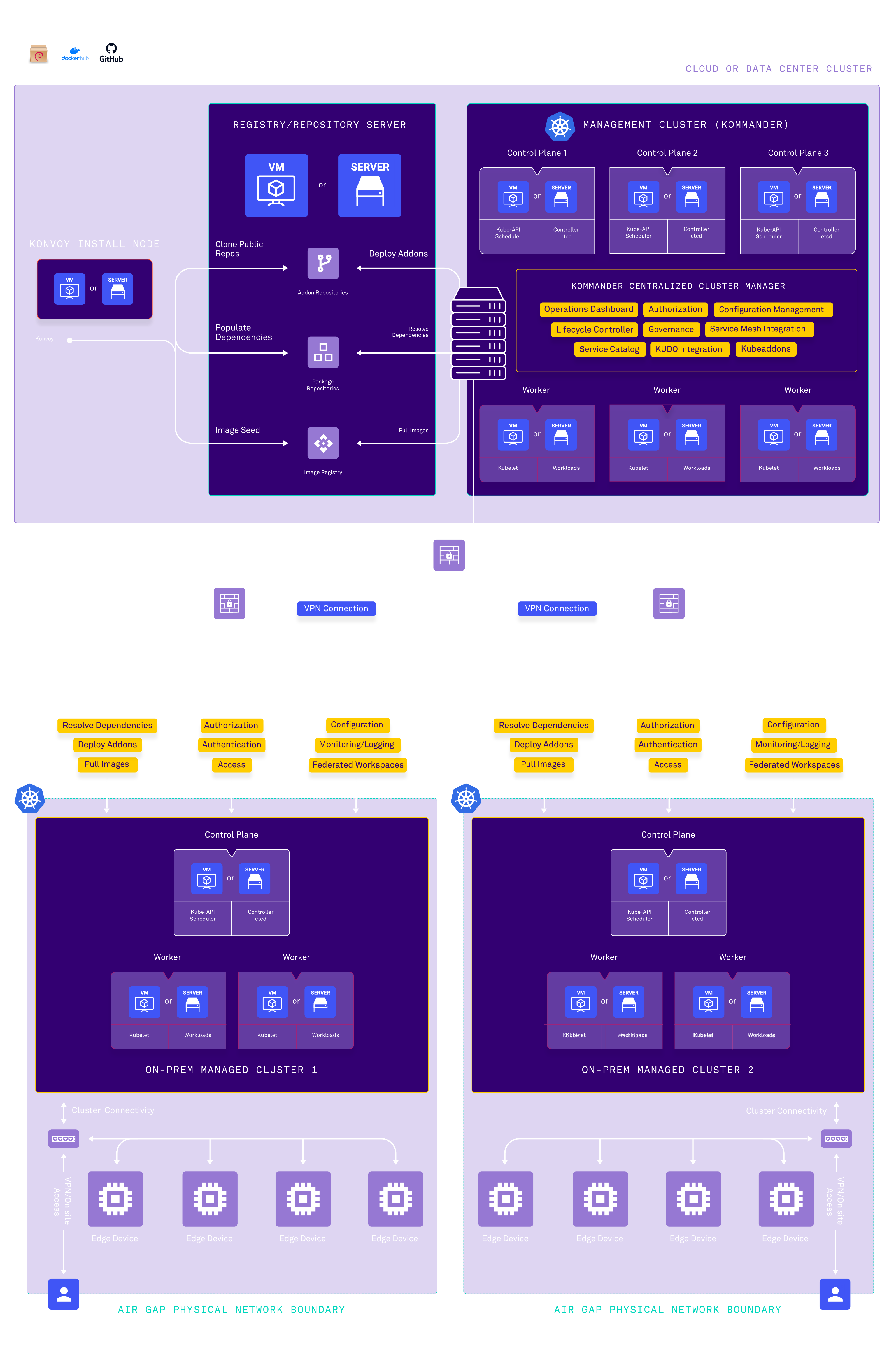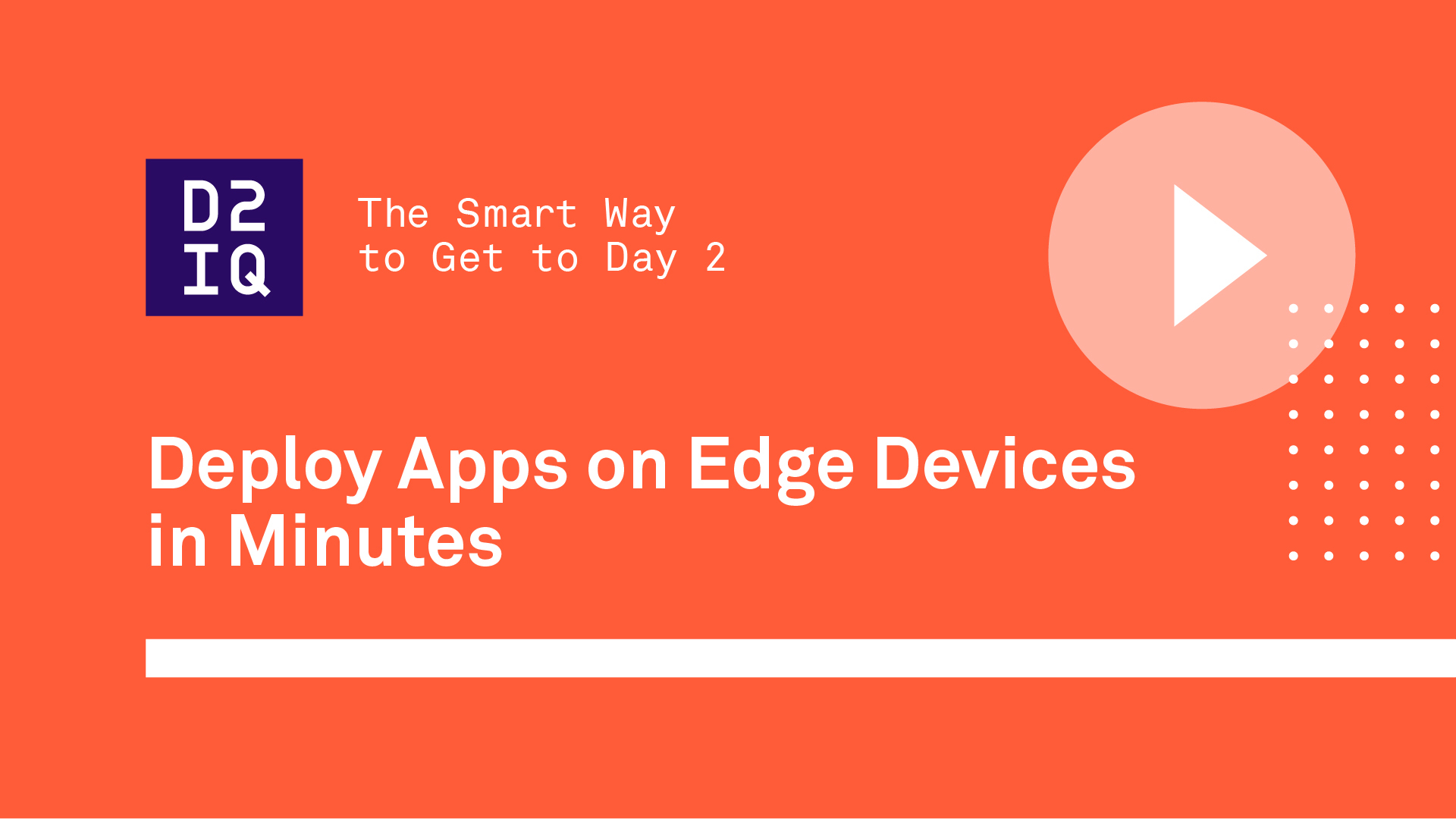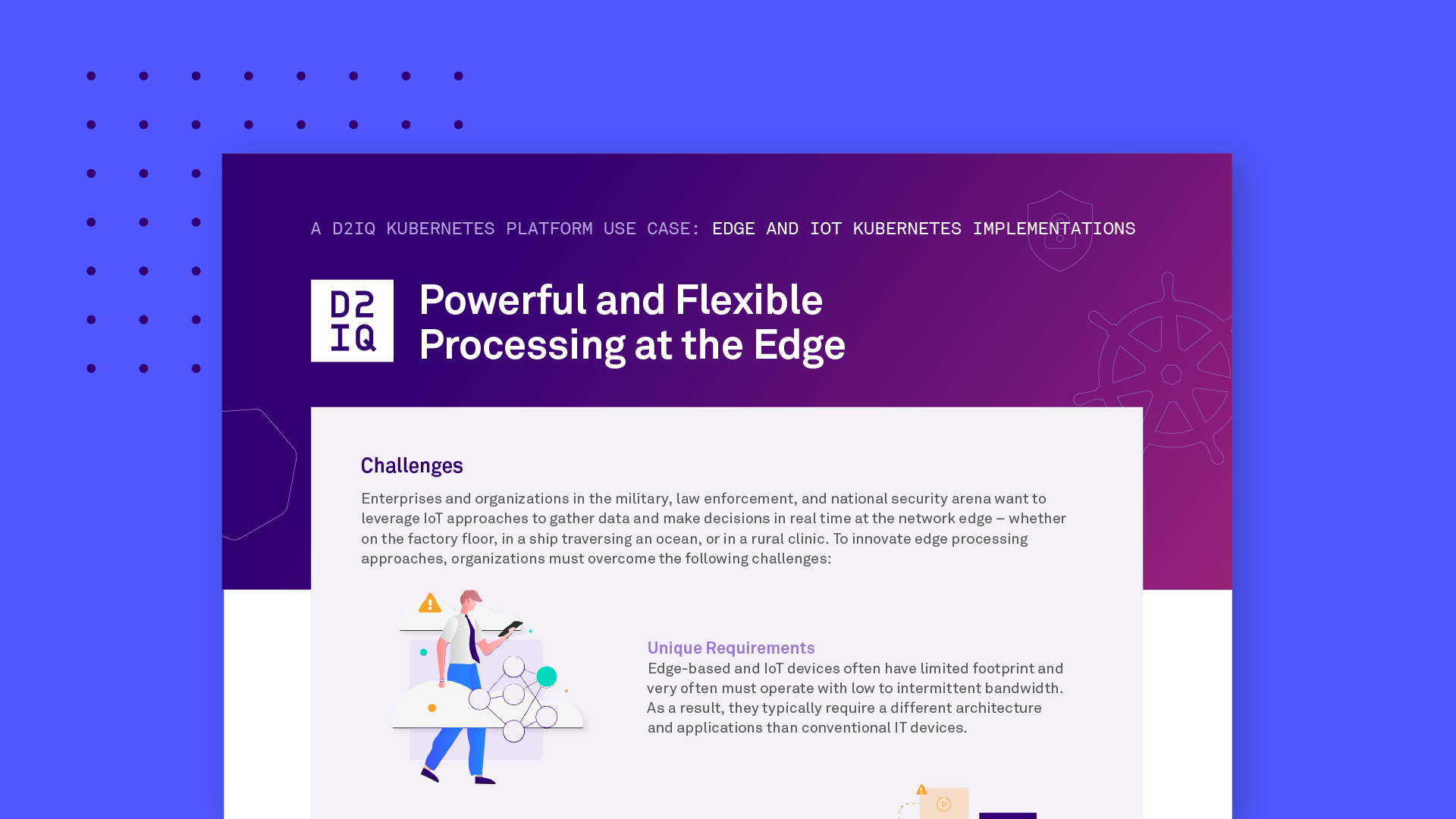USE-CASE
Deliver IoT Applications Faster and More Efficiently to the Edge
See how DKP can get you up and running in an Edge IoT environment.
Edge IoT Clusters
Organizations want to leverage IoT approaches to gather data and make decisions in real time at the network edge but are hampered by management challenges, support limitations, and reliability. D2iQ Kommander unifies management across thousands of edge sites spanning hybrid and multi-cloud architectures. Kommander supports distributions from D2iQ, EKS, AKS, and more side by side. Should an app or device fail, Kommander spins up a new instance automatically.
Edge IoT Workers
Organizations want to leverage IoT approaches to gather data and make decisions in real time at the network edge but do not want to create their own Kubernetes distribution. A purpose-built foundation for edge and IoT deployments, D2iQ Konvoy provides the core functionality demanded for the edge along with rich configuration options so tuning is about adjusting settings not coding.
Benefits of Kubernetes at the Edge
Centralized management
An edge infrastructure is typically made up of different types of computing hardware resources and software applications. Kubenetes provides a universal management plane for organizations to manage a diverse set of workloads across different edge environments, eliminating the need to use multiple management tools for each environment.
Low Latency
Because Kubernetes automates the ongoing management of applications, it can automatically respond to changes at the edge. If an edge location goes down, Kubernetes can react in real-time if deployed at the edge, with minimal delay or downtime.
Easy Deployment
Kubernetes radically simplifies the application deployment process for a variety of reasons. Because Kubernetes is infrastructure agnostic, you can deploy Kubernetes on virtually any infrastructure.
Challenges of Kubernetes at the Edge
Limited Network Connection
Admins need a way to seamlessly communicate in limited or intermittent connectivity environments. If you have sensors located in the depths of a mining site and it’s designed to alert you if there are hazardous particles, how do you power it? Or if you’re operating ships on the open sea that span multiple destination points, how do you bring connectivity to these far reaches of the network? Organizations will need to find a way for edge environments to work within an unpredictable network landscape when network is limited or connectivity is lost.


Compute and Power Resource Constraints
While IoT devices benefit from their compactness and small form factors, they often face significant resource constraints in terms of both compute and power resources. As a result, businesses that rely on data-intensive processes, such as analytics and video streaming, may not be able to run everything because these tasks require a lot of compute and power resources at the edge. The challenge becomes how to effectively monitor and track the performance and reliability of IoT devices at scale.
No Tolerance for Downtime
In an edge environment, there is no tolerance for downtime. If a medical device goes down that monitors a patient’s vital signs or administers medication, it can result in high-risk situations, or even life-threatening ones. And when a deployment fails due to a break or an early deployment without all of the requirements met, admins must shift their attention from other work as they try to reverse the damage. This results in slower time-to-value for edge environments and an increase in operational overhead and opportunity costs.

How D2iQ Kubernetes Platform Delivers Success at the Edge
Manage Infrastructure Declaratively
Ensure Zero Downtime at the Edge
DKP leverages Cluster API (CAPI) to automate many of the formerly manual processes required to keep systems running as desired. If a node fails, CAPI automatically discards non-working nodes and provisions new ones. This self-healing capability significantly reduces the operational effort of cluster lifecycle management and gives you peace of mind that mission-critical IoT applications can run and be updated with zero downtime.


Securely Connect to Edge and IoT Devices
Enable Control Plane-Node Communication
DKP’s network tunneling feature is uniquely designed to provide centralized multi-cluster management of edge environments with limited connectivity or with firewall boundaries. With this unique capability, communication can take place unidirectionally, as needed, to remove the need for always-on bi-directional connectivity between the control plane and clusters. This makes it possible to securely and reliably connect to a large number of disparate IoT devices, no matter where you are, what environment you use, or where that environment lives.
Deliver Better Resource Utilization
Deploy Kubernetes to the Edge at Scale
DKP’s CAPI-Based Autoscaling feature automatically scales up and down infrastructure capacity based on the resource needs of the running workloads. This not only provides uninterrupted application availability, but dramatically reduces the time and costs of having to constantly monitor the system for resource constraints.


Deliver Centralized Management and Governance
Standardize Kubernetes Across Devices, Teams, and Infrastructures
DKP provides centralized visibility and unified operational control for any edge infrastructure or Kubernetes distribution. This capability ensures that an organization can deliver the management and governance needed to deploy and maintain edge and IoT applications repeatedly and reliably, accelerating time-to-value.
Key Features and Benefits
Operational Dashboard
Provide instant visibility and operational efficiency into the Kubernetes landscape from a single-view control plane.
Cluster Analytics
Collect, normalize, and infer cluster performance, workload metrics, data services, user/cluster activities, and more to deliver better resource utilization.
Centralized Observability
Gain deep insight into your Kubernetes clusters and applications with open-source metrics leveraging Telegraf, Prometheus, and Grafana.
Service Catalog
Quickly and easily deploy applications and complex data services from a centralized service catalog to specific or multiple clusters, with governance.
Cluster Autoscaling
Save operational costs by scaling down capability when it’s not needed, and add capacity when there is greater demand.
Lifecycle Automation
Ensure consistent upgrades, deployment, and security policies for both infrastructure (through CAPI) and applications (through FluxCD).
Service Mesh Integration
Add advanced networking capabilities, such as multi-cluster and cross-cluster service discovery, load balancing, and security across a variety of hybrid, multi-cloud, and air-gapped environments.
Networking and Routing
Enable unidirectional connectivity between the control plane and clusters with Kubetunnel.
Governance Policy Administration
Meet the requirements of security and audit teams with centralized cluster policy management.
Centralized Authorization and Authentication
Enable single sign-on (SSO) across an organization’s cluster footprint and govern authorization with RBAC and Open Policy Access to enhance security and reduce risk.
Edge IoT Success Stories:
Thank you. Check your email for details on your request.











